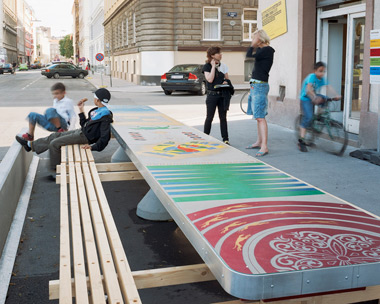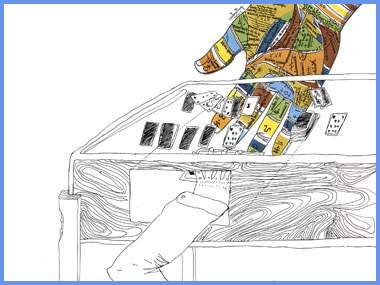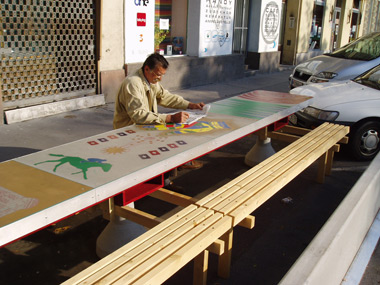
Michael Hieslmair/ Maruša Sagadin
Tisch- und Bankinstallation im Volkertviertel, im Rahmen von Geschichten vor Ort, Kunst im öffentlichen Raum Wien, 2006

Kunst als verbindendes Element – so lautet wohl der größte gemeinsame Nenner der gemeinsamen künstlerischen Aktivitäten von Maruša Sagadin und Michael Hieslmair. Wobei Sagadins und Hieslmairs Kunst-Verbindungen, die oftmals auf sozialwissenschaftlichen Recherchemethoden fußen und fast immer betroffene AkteurInnen involvieren, auf ganz unterschiedlichen Ebenen ablaufen: Sei es zwischen einem architektonischen Diskurs – die KünstlerInnen sind von ihrem absolvierten Erststudium her ArchitektInnen – und einer künstlerischen Praxis, zwischen Wien und Graz, ihren zentralen Wohn- und Arbeitsstädten, zwischen ruralen und urbanen Kulturen (Bühne Land, Graz 2006) oder zwischen mikro- und makropolitischen Raumordnungen (Saison Opening, Wien 2005). Die Liste ließe sich fortsetzen. Zentrales Anliegen – so die KünstlerInnen – sei ein Rückbinden globaler Phänomene auf den lokalen Kontext und ein Aufspüren überformter lokaler Prägungen im Globalen. Kurzum, Sagadin/Hieslmair beschäftigen sich mit Integration. Oft im Widerspruch zum herrschenden Zeitgeist. Etwa in Bezug auf Sitzgelegenheiten im öffentlichen Raum.

Denn Parkbänke werden derzeit tendenziell eher entfernt, Sitzgelegenheiten derart konzipiert, dass sie eine längere Verweildauer unwahrscheinlich machen, auf Bahnhöfen patrouillieren Security-Dienste und am Grazer Hauptplatz – als kleines österreichisches Beispiel – versperrten Lorbeersträucher vor nicht allzu langer Zeit das Erzherzog-Johann-Denkmal und seine beliebten Sitzflächen. Ohne Zweifel, Herumsitzen und –lungern im zunehmend privatisierten öffentlichen Raum ist in der jüngsten Vergangenheit schwieriger geworden, die Shoppingmall, in der alle frisch, fröhlich, flott dem Konsum frönen und soziale Probleme vom Wachpersonal hinauskomplimentiert werden, zu einem gesellschaftlichen Leitprojekt avanciert. Sitzen nur in Verbindung mit Konsumieren.

Diesbezüglich ticken die Uhren am Volkertplatz in der Wiener Leopoldstadt noch etwas anders – ein Umstand, auf den auch Maruša Sagadins und Michael Hieslmairs „Banca di blanko“ verweist. Unweit des Marktes am Volkertplatz lädt ihre „kommunikative Installation“ – auf den ersten Blick ein länglicher, etwas ungewöhnlicher Tisch mit zwei Bänken – zum Verweilen ein. Ein Angebot, dass die migrantisch geprägte Nachbarschaft auch gerne annimmt. Kommunikationssituationen entstehen dabei allerdings nicht nur direkt am Tisch: Die Lage der Installation – direkt am Eingang des Ateliers von Sagadin und Hieslmair – erlaubt ebenso eine niederschwellige Kontaktaufnahme zwischen AnrainerInnen und KünstlerInnen, erleichtert Letzteren die Integration im Grätzel.
Dies ist jedoch bloß eine Lesart der Installation. Denn mit Bemalung und in Konstruktionsdetails („doppelter Boden“) verweisen die KünstlerInnen auf einen Trend, der sich derzeit nicht nur im Internet, sondern ganz konkret u.a. auch im Viertel um den Volkertplatz beobachten lässt: Wettbüros und Glückspiel boomen, die Anzahl einschlägiger Lokale nimmt zu, eine Tendenz, die übrigen mit dem konstatierten Zurückweichen des öffentlichen Raums korrespondiert. Im Zeitalter einer nahezu dogmatischen Liberalisierung zieht sich der Staat zunehmend zurück, privatisiert bzw. kommerzialisiert öffentliche Räume und überlässt zuvor aus Gründen des Gemeinwohls reglementierte Bereiche nunmehr den Kräften des freien Marktes.

Durch seine doppelte Bezugnahme, der Andeutung von Glückspiel im öffentlichen Raum – und nicht wie üblich in privaten Lokalen – produziert „Banca di blanko“ eine subtile Widersprüchlichkeit, bricht sachte mit Erwartungshaltungen. Und kann bzw. könnte gerade dadurch Gespräche über soziale und kulturelle Grenzen hinweg anregen. Ohne dass kunstferne AnrainerInnen a priori verschreckt würden. Als kleiner kommunikativer Anker, der zu Gesprächen führen kann. Völlig unspektakulär, aber dennoch produktiv.
Text: Herwig G. Höller
Fotos: Iris Ranzinger
Yet at the same time, Sagadin and Hieslmair's art connections, which are often rooted in social sciences research methods and almost always involve relevant actors, take place at very different levels: whether it is between an architectural discourse – both artists originally trained as architects – and an artistic practice, between Vienna and Graz, their central living and working locations, between rural and urban cultures (Bühne Land, Graz 2006), or between micro- and macro-political spatial structures (Saison Opening, Vienna 2005). The list could go on and on. According to the artists, their central concern is to tie global phenomena into the local context and to discover reshaped local influences in the global context. In short, Sagadin/Hieslmair deal with integration. Often in contradiction to the dominant spirit of the times. For instance, in relation to seating in public space.
Indeed, there is currently a tendency for park benches to be removed. Seating is conceived in such a way that a longer stay is made unlikely. Security services patrol train stations, and it was not long ago that in the main square of Graz – as a small Austrian example – laurel bushes blocked the Archduke Johann monument and its surfaces popular for sitting. Without a doubt, sitting and lounging around in increasingly privatized public space has become more difficult recently; the shopping malls, where everyone happily, eagerly cultivates consumption, and social problems are escorted out by the security guards, have become a model social project. Sitting down only in conjunction with consuming.
In this respect, the clocks in Volkertplatz in the Viennese district of Leopoldstadt still run differently – a fact to which Maruša Sagadin and Michael Hieslmair's "Banca di blanko" also refers. Not far from the market at Volkertplatz, their "communicative installation" – at first glance an elongated, somewhat unusual table with two benches – invites people to linger. It is an offer that the migrant-influenced neighborhood is happy to accept. However, communication situations do not only arise directly at the table. The situation of the installation – right at the entrance to Sagadin and Hieslmair's studio – enables a low threshold for making contact between the residents and the artists, making it easier for the latter to become integrated in this enclave.
Yet this is only one way of reading the installation. With the way it is painted and in the details of its construction ("false bottom"), the artists also refer to a trend that can be currently observed not only on the Internet, but also specifically in, among other places, the quarter around Volkertplatz: betting offices and gambling are booming, the number of associated establishments is growing, a tendency that also corresponds to the aforementioned retreat of public space. In an age of almost dogmatic liberalization, the state is withdrawing more and more, privatizing or commercializing public spaces and turning over areas previously regulated for the common good to the forces of the free market.
With its double reference, the suggestion of gambling in public space – and not as usual in private establishments – "Banca di blanko" produces a subtle contradictoriness, gently breaks with expectations. And specifically in this way, it is able to stimulate conversations across all social and cultural boundaries. Without scaring off non-art-related local residents from the start. As a small communicative anchor that can lead to conversations. Completely unspectacular, but nevertheless productive.
Text: Herwig G. Höller, 2007